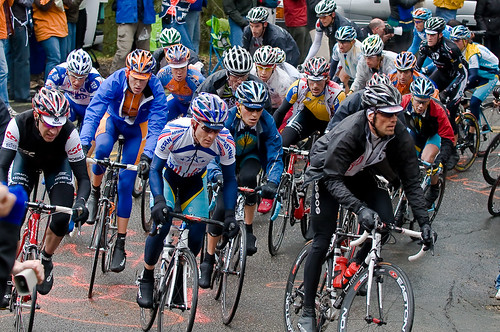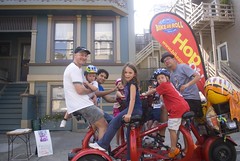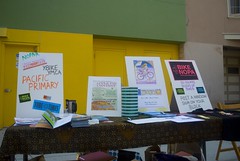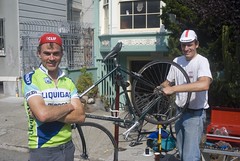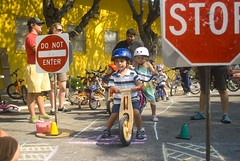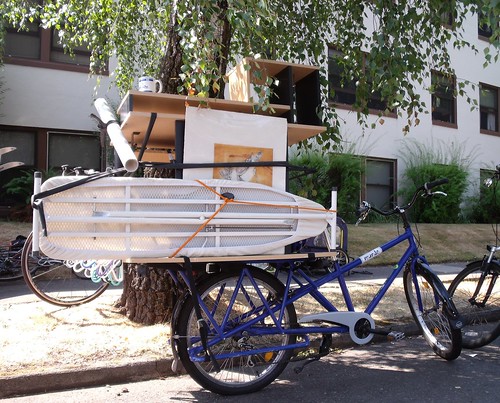
photo by Larrybobsf from Flickr
For the first time the wildly popular Sunday Streets will grace the thoroughfares of the Western Addition including the sights of Alamo Square and NOPA, if current planning holds through the decision process. Cheryl Brinkman, President of the Board of Livable City, and one of the primary organizers of Sunday Streets, reported that a Central City route will be included in next year’s street celebrations.
“The Civic Center and Tenderloin streets remain uncertain,” Brinkman explained, “but a western loop through the Western Addition, Alamo Square and NOPA has been outlined as a strong possibility.” Although she cautioned, "there's no done deal yet," the plans now call for the loop to include segments of Baker, Fulton, and Steiner Streets and Golden Gate Avenue.
The Western Loop: Beginning at the western end of the route, Brinkman said they hoped to link up with the Panhandle Path at Fell and Baker. From that point walkers, bikers, neighbors, and visitors will continue north on Baker for three blocks to Fulton, turn right and continue east crossing Divisadero to Steiner. From Steiner the route heads north to link up with the Kimball Playground at Geary before returning on Steiner to Golden Gate for a return to the Civic Center. Of course, Sunday Streeters can start at either end of the route or anywhere in between.
Brinkman said the organizers are encouraged that residents in NOPA and Alamo Square have expressed interest in having the street festival include their neighborhoods. As a result, she said, “We’re working to make it happen.” Brinkman added that part of the Divisadero Corridor might be added if merchants are interested and other factors permit it.
The Central City route with its western loop brings new attractions and features to Sunday Streets: hills, for one. Sooner or later the summer festival had to include San Francisco’s basic vertical realities, and Fulton Street west of Webster will add more cardio to the walk or ride. The western loop will also include many more residential blocks than have previously been part of the mix.
After two years of experience, the organizers are adept at anticipating difficulties and calming concerns. For instance, the western loop will permit a drive through for McAllister Street traffic, including the #5 Fulton bus. With a Sunday event, planners must also consider the impact on churches with services that day, but Brinkman said this hasn’t been a significant problem.
“In the Bayview and in the Mission our routes this year passed many churches. But we worked with them and found that if we gave them enough notice and a chance to inform their congregations, there was no problem.” Brinkman added, “Some of the churches kept their doors open during services and a few held services outdoors for all.”
Parking problems? Somehow it’s never as bad as many fear. Organizers for last year’s Bay to Breakers run, for example, secured free parking at the Department of Motor Vehicles lot on Fell Street to address concerns from NOPA motorists. When the time came, only three vehicles were parked in the lot.
Baker and Divisadero Street merchants will likely find Sunday Streets a real boon to their businesses. Earlier this year Valencia Street merchants couldn’t wait for the second round of Sunday visitors after the first Sunday Streets included their blocks.
Central City festivities will likely occur in August and September or September and October of next year, according to Brinkman. Sunday Street routes are usually repeated on two consecutive months. “There’s just too much work to do a separate route for each Sunday event.” In 2010, organizers expect to launch nine Sunday events with five routes.
Brinkman encourages residents along the routes to send their suggestions for activities they’d like to have on their neighborhood blocks. In the past Sunday Streets has featured exercise classes, yoga, hula hooping, bike skills courses for kids, rental bikes, bike repair stops, lots of bands, and, of course, non-stop people watching. Send ideas and requests to sundaystreets@gmail.com .
For NOPA neighbors: Brinkman will present Sunday Streets plans at the November NOPNA neighborhood meeting. (Thursday, November 19, 7pm social, 7:30 meeting at Poleng Lounge, 1751 Fulton between Masonic and Central).
Note: Mayor Gavin Newsom proclaimed Sunday Streets an annual celebration and made the Municipal Transportation Agency the official sponsor. Livable City manages day-to-day operations, and the San Francisco Bicycle Coalition handles the volunteer program under contract. Volunteers are needed for marketing, social networking, and a range of other activities. (The organization really wants help upgrading its website!) Contact sundaystreets@gmail.com .











